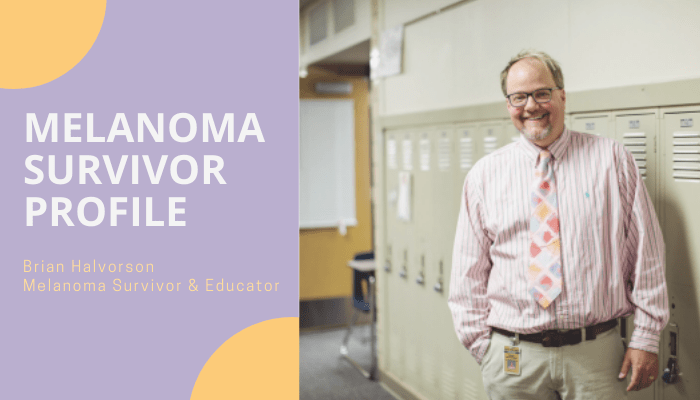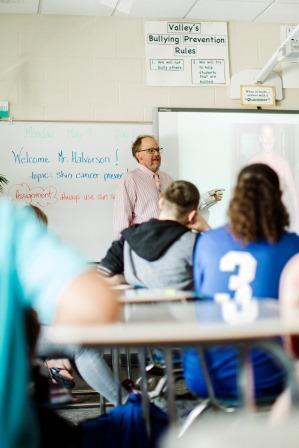Featured Survivor Story:
Survivor Spotlight: Brian Halvorson

Melanoma and The Sun
By Mara Klecker
More than 11,000 students have heard Brian Halvorson tell the story of his melanoma diagnosis and treatment.
He grew up in a small town in North Dakota where the favorite summer pastime was hanging out at the pool. By the time he was a teenager, Brian got a job as a lifeguard and was spending long days out in the sun. Applying sunscreen wasn’t even a thought, he said.
“We didn’t even know much about sunscreen,” he said. “That came back to get me when I was 37 years old.”
In 2007, about six months after a small spot first appeared on his cheek, Brian’s wife pushed him to make his first dermatology appointment. A biopsy revealed that the spot was melanoma.
When he got the call with the news, Brian went to his computer and typed in the word “melanoma.”
“I saw the words ‘the deadliest of skin cancers’ and I knew I was in trouble,” he said.
Six weeks after doctors removed the spot on his cheek, Brian noticed swelling in his neck. The cancer had spread to a lymph node.
“You know it’s not good when you hear them say that it’s spreading,” he said. “I was pretty scared.”
Brian traveled to Mayo Clinic in Rochester, Minnesota, for a neck dissection and radiation, which was followed by three years of immunotherapy. In the days between the radiation treatments, Brian spent his downtime thinking about how he could use his position as a teacher to spread awareness about melanoma. He started crafting the first iteration of a presentation he’s now given more than 530 times to middle and high schoolers in Grand Forks, North Dakota.

It hit one day as I was going through radiation that as an educator I need to get my message out to as many kids as possible. I now do an hour-long presentation on skin cancer and the dangers of not wearing sunscreen.
“My big message to kids is that they’re not invincible, which can be a hard message to get across to teenagers,” he said. It’s a lesson that he said he didn’t learn until his diagnosis.
“I tell them that up until I was 37, I also didn’t worry about my health,” he said. “I still had that attitude that nothing was going to hurt me.”
When visiting health classes around the city, Brian reiterates the importance of wearing sunscreen and of annual dermatological exams. He has also started bringing a skinscope that allows students to see the sun damage on their own faces. Because he gives his presentation to seventh graders and then again during their sophomore year, students can see just how much sun damage they get from not wearing sunscreen for a few years.
“That’s always quite the eye-opener for them,” he said. He wants teenagers to realize that the decisions they are making now about not wearing sunscreen or using tanning beds could be causing lasting damage.
“I just say that it could catch up to them as it did for me,” he said.
When he’s working with his own students, Brian is always reminding them about sunscreen. If they tell him about an upcoming vacation and ask about any assignments that they’ll need to take with them, he tells them that their homework is to wear sunscreen while they’re enjoying their trip.
When Brian was first diagnosed, he felt the “Why me?” question enter his mind. But he feels that he’s found his answer: He was supposed to use his own melanoma experience to educate young people and spread awareness.
So far, Brian’s cancer has not returned. He is now visiting his dermatologist once every six months to make sure the new spots that are appearing aren’t a danger.
As he ages, Brian is noticing more and more of the ways that his time in the sun as a teenager shows on his skin, he said.
But age, and his cancer journey, has brought something else, too: “I’ve let go of that ‘nothing can happen to me’ attitude and started taking care of my body,” he said. “I can’t say it enough to the kids: Do what I never did — wear sunscreen.”
Special Event
Join Brian on Wednesday, May 5th for a virtual discussion on “Managing or Pursuing a Career with a Cancer Diagnosis.” More information can be found HERE.






